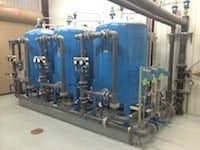Supai, Ariz., the capital of the Havasupai Indian Reservation in the western Grand Canyon, is one of the most remote villages in the U.S. The nearest surfaced road is nearly nine miles away, and the town is the only place in the country where mail is still carried out by mules. These facts would prove to be significant challenges when the U.S. Environmental Protection Agency (EPA) established its more stringent arsenic maximum contaminant level (MCL) of 10 ppb, effective in 2006.
Project Background
Soon after the new arsenic MCL took effect, the Havasupai Water Treatment Plant—along with many other treatment plants, particularly in the Southwest—was found not to be compliant. Using only chlorination to treat the arsenic contamination so common in Arizona and surrounding states, the arsenic levels of the Reservation’s water sources ranged from 10 to 12 ppb—lower than levels found in drinking water elsewhere in the region, but still higher than EPA standards.
In response, the Havasupai Reservation began a search for a treatment system that would help it meet EPA standards. Ultimately, they chose Severn Trent Services’ SORB 33 arsenic removal system, utilizing Bayoxide E33 arsenic removal media over other options such as coagulation/filtration. The reservation is in good company, as approximately 150 SORB systems are currently in use at water treatment facilities throughout the West and Southwest.
Benefits of Iron Oxide Adsorption
The SORB 33 arsenic removal system is simple to operate and requires no cleaning, no regeneration and no complex, labor-intensive steps. It is a fixed-bed adsorption system, employing a simple "pump and treat" process that flows pressurized well or spring water through a fixed-bed pressure vessel containing the iron-oxide media. Arsenic has a high affinity for iron-oxide-based minerals and can adsorb quickly to the surface of the media. This makes granular iron oxide media, such as Bayoxide, excellent for arsenic removal. Both arsenite (arsenic III) and arsenate (arsenic V) oxyanions are removed from water via a combination of oxidation, adsorption, occlusion (adhesion) or solid-solution formation by reaction with ferric oxide ions.
Other contaminants common to groundwater also have a high affinity for iron-based minerals. This creates competition among ions, resulting in less arsenic being adsorbed per volume of treated water. But Bayoxide E33 is specifically designed to adsorb arsenic while reducing competition with other ions, thus improving the arsenic-adsorbing potential of the media.
The SORB system is easy to operate, and even with the cost of replacing the media in two to three years, the system’s operation and maintenance costs are considerably less than the coagulation/filtration process. In addition, the system generates much less waste than coagulation/filtration—not an insignificant benefit given the inability to simply remove waste sludge by truck in this remote location.
The Challenge: How to Deliver the System
Because of the reservation’s remote location, the SORB 33 ARS-48T system was helicoptered in to Supai. To accommodate the unusual delivery method, the SORB vessels were not mounted to a triplex, structural steel skid, as the equipment typically is shipped. Instead, each vessel was shipped complete with individual face piping only. Piping headers for influent, effluent and rinse/waste were shipped loose for reassembly by Technologies Construction of Prescott, Ariz.
The SORB system consists of three pressure vessels, each measuring four feet in diameter, capable of treating 200 gpm. Operating in parallel, the vessels contain three feet of the Bayoxide media each. Sixty to 80 percent of the influent flow to the plant is bypassed.
After going into operation in October 2014, water from the Havasupai Plant has been fully compliant with EPA standards.
“We are very happy with the SORB system," said Armando Marshall, the Havasupai facilities and maintenance manager. "We heard of the high level of performance the system achieved at other treatment facilities in the region, and our system’s performance has certainly matched our high expectations.”
Martin Lawrence is process engineer - inorganic contaminants for Severn Trent Services. Lawrence can be reached at [email protected] or 813.886.9331.


